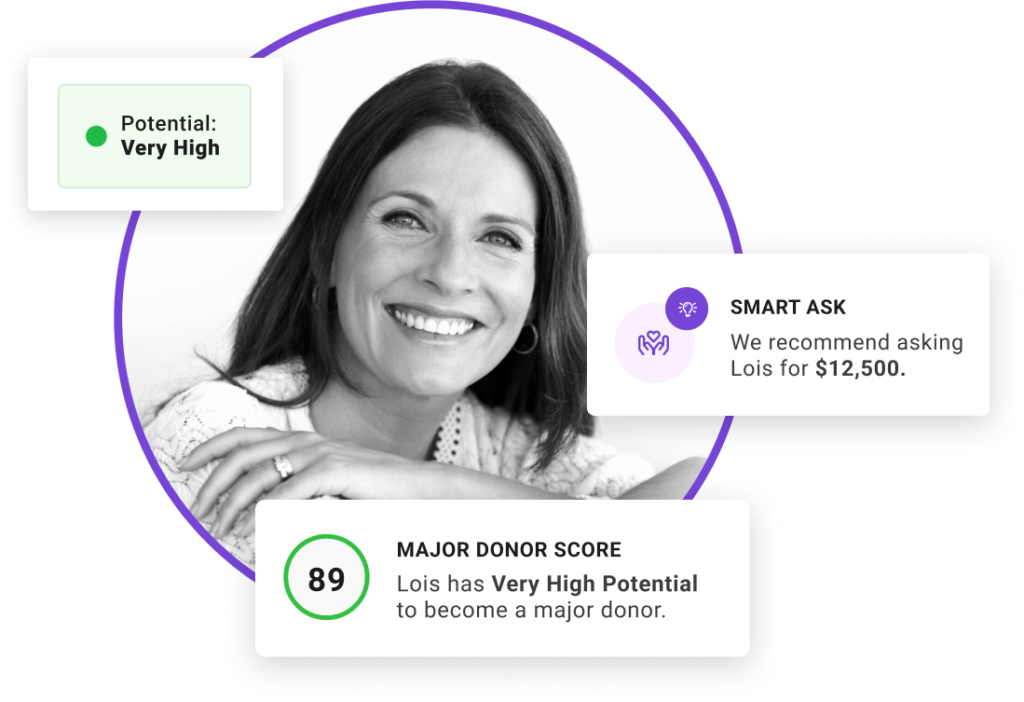From self-driving vehicles to automated checkouts at your local grocery store, Artificial Intelligence (AI) tools are disrupting the norm in several sectors. AI-powered solutions are undoubtedly the most on-trend technology right now. As algorithms become more complex and solutions far exceed human capabilities, they are increasingly being adopted each year.
About 50% of nonprofit activities (not jobs) can be automated using AI, leading to more efficient and productive organizations.
This is the future of work: machines will carry out more manual tasks, more computers will run analyses faster and more detailed than human minds can, and humans will have more space and time to think strategically and push their business agendas forward.
But how does this translate to the nonprofit sector?
More nonprofit organizations are beginning to harness AI technology to understand their supporters’ needs, improve the efficiency of their outreach efforts, and of course, raise more money.
But NPOs are built on humanity, so will we really replace the human elements of donor outreach, relationship-building, and stewardship with AI-powered automation tools?
With this question in mind, let’s take a look at what artificial intelligence and automation are and how they could revolutionize your day-to-day work.
Nonprofit AI and Automation: What’s the Difference?
If we want to understand how artificial intelligence and automation can impact our work, we need to tell them apart.
Automation refers to a wide range of technologies rather than a single one. While Artificial intelligence can be a form of automation, automation does not always involve AI.
Essentially, automation substitutes human labor in tasks (again, not jobs) that are both predictable and routine, whether that’s on a manufacturing line or using personalization tags in your next fundraising appeal. The goal is to reduce the time and effort spent to get results.
AI-powered automation is used when a machine learns to perform repetitive tasks and do so with cognitive capabilities to facilitate decision-making. Machine learning deploys algorithms to find patterns in large quantities of data—it is less about the tasks and more about the intelligence or knowledge derived from after performing the tasks.
About 50% of nonprofit activities (not jobs) can be automated using AI, leading to more efficient and productive organizations.
How Nonprofit AI-Powered Automation Tools Work
AI-powered automation is used when a machine learns to perform repetitive tasks and do so with cognitive capabilities to facilitate decision-making. Machine learning
Revisiting our example of self-driving vehicles, we can look at automation using AI: the process of driving has been automated, and the brains behind this automation—automatic steering, braking, and perception of what is happening on the road—is the AI component.
Let’s discuss a nonprofit-specific example: Crisis Text Line, a New York City-based nonprofit, used AI automation to analyze more than 65-million text messages they received automatically.
In this case, AI was used to learn what words in those text messages were most associated with a high risk of suicide. Knowing what trigger words to look out for, the team could triage messages and respond to 94% of high-risk messages in under five minutes.
This is just one example of how nonprofits are deploying innovative, smart technology to complement their work. And, with technology budgets for organizations increasing by up to 48%, more and more of our day-to-day work will be enriched by AI-powered automation.
5 Tasks Nonprofit Can Automate Using AI
1. Prospect Research
In most donor pools, the top 10% of donors make up 90% of the donations. And an integral part of your job as a fundraiser is to build and nurture the right relationships with potential major gift donors. But the real challenge lies in identifying and directing resources towards that 10%.
Typically, this equates to spending hours every day working through donor lists and reviewing more contacts than is humanly possible. Besides not being sustainable, this is simply not an efficient use of your time.
By using AI-powered automation to dig through donor data and identify prospective major gift donors, you can get half of the work done. More so, you can spend less time working through endless administrative work and focus on connecting with and engaging these new-found donors over time.
Many industry-leading tools are dedicated to determining your donor pool’s propensity, capacity, and affinity to give, and you can read all about them here.
FREE Donor Profile Template for Fundraisers
Use this template to record and track important details about your donors and prospects so you can target the right individuals for the right fundraising campaigns.
2. Making the Ask
Making the ask is arguably the most challenging part of a fundraiser’s job. Your success rides on who you ask, how you ask, and how much you ask for. Make the wrong ask, and you will end up with peanuts. Yet, determining how much a donor is willing to give is part science, relational, and intuition.
AI-powered automation tools have made big strides in revolutionizing the science behind the ask as they can perform sophisticated analysis on donor data sets. Innovative tools, like KIT’s Smart Ask, recommend the ideal amount to ask your donors for by analyzing giving habits, giving capacity, and even time of year to ensure you ask for the right amount, at the right time, from the right donors.
3. Personalized Communications
AI-powered automation tools have made big strides in revolutionizing the science
The more insights you have about your donors, the better and more targeted your fundraising messaging becomes. Machine learning finds the patterns in your donor data and AI helps extract insights, from these patterns, that you can use to create more personalized communications.
In Fundraising KIT, these insights will appear as a badge on a contact’s profile—and together, they offer an unmatched overview of your donors, and how engaged they are with your fundraising efforts.

However, the technological advances in this space don’t stop at insights. Once you know who to reach out to, how they prefer to be reached, and what segments they belong to, you can use AI-powered tools to write your fundraising emails.
Start Segmenting Your Donors
Use this FREE Donor Segmentation Template to segment your donors and contacts based on their level of engagement.
4. Live Chat With Supporters
Keeping tabs on top donors can be a challenge, let alone an entire pool of supporters. Yet, a strong foundation of communication is how you move each supporter—regardless of donation size and frequency—through the donor funnel.
Using a chatbot to automate conversations for frequently asked questions is a simple, practical application of AI-powered automation. This lessens the tedious work of replying to routine questions. Plus, instant communication, whether with humans or software, increases satisfaction.
5 Nonprofit Tasks That Can Be Automated using AI
Live chatting software has a 73% satisfaction rate for customer interaction (G2’s Facebook Chatbots Guide, 2018.)

40% of millennials say they interact with chatbots daily (Acquire.io, 2018).

64% of users say a chatbot’s 24-hour service is the most enticing feature (The State of Chatbots Reports, 2018).
Major donors typically make up 12% of an organization’s donor base, and this subset One example of an innovative, AI-driven chatbot is Charity: Water’s Yeshi. Its sole function is to educate people about clean water. It engages in smart conversations by answering questions and sharing resources using maps, images, videos, and text. This helps build an emotional connection with supporters through storytelling, all without human staff having to lift a finger.
5. Nonprofit Reports
One of the big nonprofit trends in 2021, and in years to come, is the need for data-driven strategies. By tracking and analyzing data around the work you do, your organization can make educated, data-driven decisions on what to focus on next. Reporting is important, but it does not have to be time-consuming.
KIT’s reporting automation tools can easily pull data from records—no need to deploy your database administrator for this task—and create on-demand fundraising reports. Using easy-to-understand data visualizations, these reports will inform and direct your activities, allowing you to adjust fundraising strategies on the fly.
Get Timely, Actionable Donor Insights with Fundraising KIT
Using Fundraising KIT, you can enrich your fundraising data with Major Donor Score insights. Book a demo today to learn how KIT helps you uncover patterns and trends in your donor data.
Nonprofits Can Make More Impact with AI and Automation
Artificial Intelligence and Automation are powerful tools that increase impact and build loyalty with supporters. But to wield this technology effectively, you need to ensure proper data collection and management practices.
When using machine learning algorithms on clean data sets, you will be rewarded with operational efficiencies beyond human comprehension. Without clean data, you are more likely to end up with a headache.
It all boils down to using donor data effectively. Nonprofits are already affecting a significant impact in the world. Imagine how great that impact could be if you could unlock the true potential of your fundraising efforts.

Talk to a fundraising expert today to learn more about how Fundraising KIT can quickly and easily help your nonprofit raise more for your cause.

Stephen O’Neill
Marketing and Partnerships Manager at Fundraising KIT
Passionate about exploring and learning, Stephen has spent the past number of years working across marketing teams in Canada, Australia, and his native Ireland. Stephen has worked in, and written content for, a multitude of industries including the nonprofit, investment, and financial services sectors.
Away from the desk, Stephen can usually be found snowboarding in winter, camping in summer, bingeing new Spotify playlists, and touring new destinations whenever possible.







